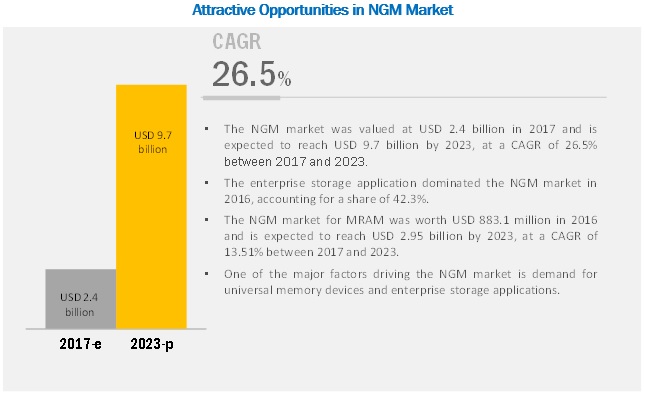The next-generation memory market is projected to grow from USD 2.35 billion in 2017 to USD 9.68 billion by 2023, at a CAGR of 26.54% between 2017 and 2023.
How growing use of nonvolatile memory in smartphones acts as an opportunity for the next-generation memory market?
Consumer electronics is an important application of nonvolatile memory technology. High-capacity memory solutions are required in various consumer electronic applications such as smartphones, tablets, digital cameras, and portable devices for storing large amounts of data. These solutions offer high-performance and consume low power. NAND memory is extensively used in smartphones. Advancements in wireless technologies are expected to fuel the demand for next-generation nonvolatile memory solutions as smartphones require high data storage capacity and transfer rates. STT-RAM is expected to be used widely in smartphones, which have high power consumption due to its high endurance and low write power requirement.
Gain a Deeper Dive on a Specific Application, Geography, Customer or Competitor.
Download PDF Brochure @
https://www.marketsandmarkets.com/pdfdownloadNew.asp?id=632
How is optimization of storage densities and capacities expected to act as a challenge for the next-generation memory market?
High-density memory solutions such as ReRAM, NVDIMM, etc., face numerous challenges in terms of their poor scalability. Scalability refers to the ability of a product to function well even when there is a change in its size and capacity. High-density memory solutions are incapable of adhering to the required levels of endurance, noise margins, and reliability. They have a limited capacity for electron storage.thus, the optimization of storage densities and capacities of high-density memory solutions acts as a challenge for the next-generation memory market.
Lack of stability in next-generation memory solutions under extreme environmental conditions acts as a restraint for the growth of the next-generation memory market
Stability under high temperatures and extreme environmental conditions are among the essential requirements for emerging memory technologies. The major advantage of traditional memory solutions is their stability and consistent performance offered under high temperatures. Hence, they are used in multiple applications wherein they are exposed to extreme high and low temperatures ranging from −40°C to 150°C. However, certain scalability and stability issues are encountered during the operations of most of the next-generation memory solutions in such extreme environmental conditions. The hybrid memory cubes operate at a temperature ranging between 0°C and 95°C, while ReRAM operates at temperatures ranging between 40°C and 85°C. These shortcomings of the next-generation memory technologies restrain their adoption in the market
Media Contact
Company Name: MarketsandMarkets
Contact Person: Mr. Shelly Singh
Email: Send Email
Phone: 1-888-600-6441
Address:630 Dundee Road Suite 430
City: Northbrook
State: IL
Country: United States
Website: https://www.marketsandmarkets.com/Market-Reports/Memristor-Memory-Market-632.html


